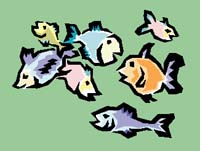|
Fish Protection in the Cedar River Watershed Cedar River is home for many species of fish, many of which have been listed on the Endangered Species Act (ESA) or are nearing listing. These species present include the Bull trout, Coho salmon, Chinook salmon, Sockeye salmon and Steelhead trout. The ESA listing requires that the remaining fish populations be protected and restored. To so do, anything that affects the viability of the fish must be evaluated. Primarily the fish are affected by the condition of their habitat, water flows, river conditions and harvesting. This means that human use of the land and waterways used by the fish might need to be altered or preserved to prevent human activities from further damaging the populations. The anandromous fish are prohibited from traveling further up the river than the Landsurg Diversion Dam by the dam itself, the Ballard Locks create a challenge to fish returning to the river. Increased land use in the urban area creates erosion that introduces excessive silt into the water. Chemical use in surrounding urban areas pollutes the water. Water temperatures and flows are altered by anthropocentric activities and of course, harvesting or injuring fish diminishes populations. The ESA requires local jurisdictions to develop and implement a plan to protect and restore populations of native species that are in serious decline. Under the ESA it is illegal to harm or kill fish. The Cedar River is Seattle’s largest supply of municipal and industrial water, critical to the survival of the city. In the process of performing normal activities related to obtaining water for the city may inadvertently harm some of the fish on the listed on the ESA. To insure that the Seattle Public Utility could continue to provide water to the city while doing all that is possible to minimize risk to the endangered species, a Habitat Conservation Plan was developed and implemented. This plan was developed with the help of five state and federal agencies and the Muckleshoot Indian tribe. Its primary goal was to sustain and restore the fish stocks and to improve the habitat for fish and other wildlife. The plan includes many stipulations which can be found on the Seattle Public Utility web site (http://www.ci.seattle.wa.us/util/watershed/cedar/hcp/overview.htm). STAKEHOLDERS: FISH PROTECTION AND ITS IMPACT
|
